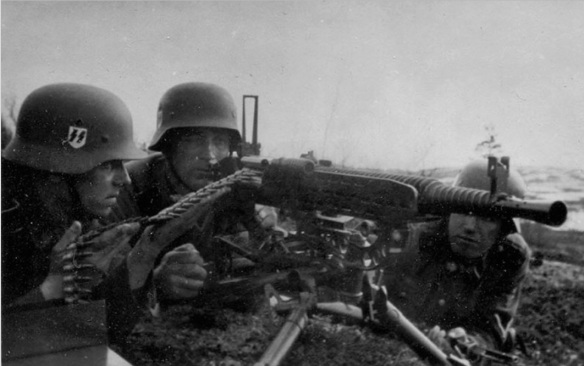An interesting photograph showing a Waffen-SS machine-gun crew with a Czech ZB37 machine gun mounted on a tripod. It was a simple, reliable and robust weapon with a quick-change capability for overheated barrels; it was widely exported and was used in British armoured vehicles as the BESA. It was also offered with a sustained fire tripod and provided with a sufficient supply of full magazines and spare barrels. The tripod could also be adapted for an AA role.
In about 1921 Vaclav Holek. the chief designer of Ceskoslovenska Zbrojovka, became interested in machine guns and eventually designed a gas-operated light gun, the Praga Model 1924, which was then improved to become the ZB26. This weapon had a long finned barrel with an ingenious quick release latch which allowed a hot barrel to be removed and a fresh one fitted in a few seconds; a long gas cylinder through which a piston acted on the breech block, tilting the rear end up to lock into the receiver; and an overhead box magazine. Very small improvements, added as experience was gained, resulted in the ZB27 and ZB30 models, and all were extremely successful, being adopted by no less than 24 countries. Probably the most famous and most widely used of this series was the British Bren gun. Holek then designed a medium machine gun for tank use, in which the principle of differential locking was modified; the gun was gas operated but the barrel and working parts were allowed to recoil and the cartridge was fired during the counter-recoil movement. This meant that the explosion of the cartridge had to arrest the forward movement before it could begin the recoil stroke, and in this way the effective recoil blow on the gun mounting was reduced. The design was adopted into the Czech Army as the ZB37, a tripod-mounted and belt-fed infantry gun. It was also taken into use by the British Army as a tank gun where it was known as the BESA. Holek’s 15mm ZB60 was also called the BESA in Britain.
Description
The ZB37 is a gas operated, air-cooled, belt fed, selective fire, weapon that fires from an open bolt. The barrel is heavily finned and can be changed quickly to provide sustained firepower. It is fitted with a conical flash hider and a carrying handle.
The action of the gun is a gas-operated system with a long-stroke gas piston located below the barrel. The gas block is fitted with a four-position gas regulator. Locking is similar to that of ZB26 – the rear end of breech-block is raised to engage a locking shoulder made in the roof of the receiver. Tipping of the breech-block is controlled by a cam-shaped projection and cuts made on the bolt carrier / gas piston extension. The action of the ZB37 is unusual in two ways. First, it has a rate-of-fire regulator in the form of a spring-loaded buffer which can be set in the path of the recoiling bolt group or brought out of action by switching a lever located at the left side of the receiver. When the buffer is out of action (swung up and out of the way of the bolt group), the bolt group can recoil the full distance back, which results in a longer operating cycle and a lower cyclic rate of fire. Once the buffer is lowered, it limits the recoil path of the bolt group, and the buffer spring uses the energy of the recoiling bolt to send it forward faster than usual, thus resulting in an increased rate of fire. The second unusual feature of the gun is that the receiver, which houses the barrel, gas drive and bolt group, is permitted to recoil within the outer housing of the weapon, against its own return spring. This spring is located above the receiver, just behind the feed unit. This buffered system is designed to decrease the vibration and peak recoil transferred to the mounting, particularly since the gun fires just before the recoiling mass returns to battery, which softens the recoil blow.
The ZB37 uses belt feed, from non-disintegrating steel belts which are fed from the right side only. The feed is of the single-stage, push-through type.
The trigger unit is mounted in a separate housing below the receiver, which also serves as the cocking mechanism. It houses a sear system, a thumb trigger (which also serves as a safety and fire mode selector), and dual folding grips. To cock the weapon, a release lever is pressed, and the entire trigger housing is slid forward. Once the bolt carrier is engaged by the sear, the trigger unit is pulled back until it is locked in its rearward position. The trigger is of round shape, and has a radial projection which serves as a safety and fire mode-selector (gun can fire either single shots or bursts). The dual grips can be folded vertically for compact storage, or set horizontally, or turned further down at approximately 45*, to better suit the firing position or the preferences of the shooter. The grips are also used to cycle the trigger unit and thus cock the gun.
Standard sights are of open type, with an adjustable rear sight mounted on the receiver and front sight mounted on the barrel. Ring-type AA sights and telescopic sights were available as options.
The ZB37 was issued with tripods of several designs, but all were made to the same high standards as the weapon itself and, again like the weapon, were rather complicated and expensive to make, although comfortable to use. The tripods were adjustable for height, so the gunner could adopt a prone or sitting position, or could provide high-angle AA fire.
